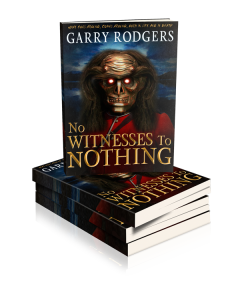The secret of good death writing is keeping the reader alive throughout.
 To do that, you must first raise a question which begs to be answered by the end of the story.
To do that, you must first raise a question which begs to be answered by the end of the story.
In Thrillers, it’s something like ‘WTF’s gonna happen to the protagonist?’
In Murder-Mysteries, it’s ‘Who dunnit or Why’d they do it?’
In Sci-Fi… “Is this even possible?’
In Romance… ‘Is she gonna get laid?’
In Literary… ‘How elegant is the prose and what new Scrabble words can I pick up?’ (No wonder Literary is fading fast.)
 I’m going to use an example from my novel, No Witnesses To Nothing.
I’m going to use an example from my novel, No Witnesses To Nothing.
And, No, I’m not trying to sell you Blog-subscribers the book. I’ll give you a free digital copy if you sign my mailing list, because that way you’ll sell it for me by WOM. (That used to be Word-Of-Mouth. Now it’s Word-Of-Mouse. I like that term!)
The central question in No Witnesses is ‘Why did the informants have to be murdered?’ Not who. It’s obvious from the opening that the ghost dunnit, because it’s a ghost story. It’s based on a real ghost story that actually happened to me when I was a police officer and it scared the living shit out of me. But then ghost stories are supposed to do that and it makes for a good hook.
So the question keeps getting raised. ‘Why did the informants HAVE to be murdered?’ And it’s answered at the end of the book, which you have to keep reading in order to find out.
 So far, readers have been very positive; most turning around and reading it a second time. The best compliment that a fiction writer could ever have is ‘I couldn’t put it down!’ and I’ve got that from even those who don’t know me.
So far, readers have been very positive; most turning around and reading it a second time. The best compliment that a fiction writer could ever have is ‘I couldn’t put it down!’ and I’ve got that from even those who don’t know me.
So that’s how to put life into a death story – raise the question of who or why they did it – which is what Murder Mysteries are about.
 Do it repeatedly and delay the answer by throwing in red herrings with twists & turns. Like Agatha Christie did.
Do it repeatedly and delay the answer by throwing in red herrings with twists & turns. Like Agatha Christie did.
Blend this with some of the basics of story-telling; a good opening hook, realistic dialogue, limited use of adjective & adverbs, carefully placed descriptors, interesting characters, the suspension of disbelief, and that old thing of show & tell.


With True Crime my interest is WHY the killer did it. Financial motives don’t hold interest unless the the author intimately acquaints me with the victim and the loved ones who go from being US to THEM, and leads me from the victim’s normal last days/day to the stone-in-the water reaching all the shores of what they left behind.. With someone who kills an acquaintance for emotional reasons, or someone who kills a stranger for internal reasons we want the author to put us in the killer’s head. We need to know WHY.
Same with fiction, but fiction allows the writer to create the history that explain the drives and delineate the thoughts leading up to the crime and thruout it. We just want to UNDERSTAND aberrations that frighten us, and if a fiction writer can gradually make sense of the senseless we are rapt. Finishing a good crime novel should be finally shutting off the the reading light you left on all night while you read it.
(finishing a good Sci-Fi novel should have you installing a nightlight… a good Romance should have you acting like a newlywed if you’re with someone or making an internet dating profile if you’re not…a good Classic should have you doing just as Garry suggested, learning archaic skills and taking advantage of giveaway prices in silver sets & dinner sets & crystal glasses ..)
But if Crime Fiction is your thing, you have to make your victims someone the reader knew personally, then throw heart & soul into being the prosecutor – or the defense – or the unbiased shrink – or just the factfinder for the killer.
IMHO